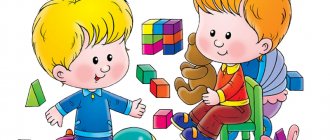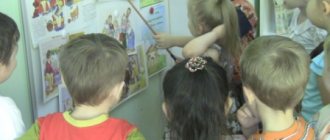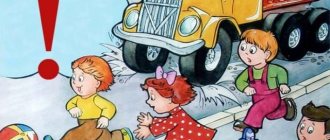Goals and objectives
The goal of the “Make a Sentence” game is to develop the lexical elements of speech and improve grammatical structure.
Tasks:
- expansion of individual vocabulary;
- learning the skill of composing simple and prepositional sentences;
- developing the ability to select homogeneous members, as well as qualities and actions for objects;
- learning the skill of expanding a sentence by adding different members;
- development of coherent speech, the ability to build a dialogue, answer and ask questions in detail and competently;
- vocabulary enrichment;
- development of imagination.
Display in spelling schemes
Before they create a sentence diagram in 1st grade, they first learn spelling patterns. The first is the capital letter in proper names. The names of cities, names of people, names of animals begin with it. In diagrams it is indicated using a vertical bar. They act as a visual aid, with the help of which they consolidate already acquired knowledge.
- Petya and Vanya will go to their grandmother in the summer. I_____ _ I_____ ____ _____ __ _____.
- Alena loves candy very much. I____ _____ _____ ____.
- Dad helped Rita and Kostya do their homework. I____ ____ I____ _ I_____ _____ ____ ____.
- Moscow and Volgograd are located in Russia. I___ _ I____ ____ __ I____.
Later, children learn about such a concept as dialogue. In the alphabetic period, the first knowledge about direct speech is laid. Students learn that sentences begin with a capital letter, and each new line is preceded by an unusual dash sign.
-Who ate all the candy? — I___ __ ___ ___?
- Children! - I___!
Children already in the 1st grade are drawing up a sentence diagram with all punctuation marks. This will help you write words correctly, and when reading, highlight punctuation marks using intonation.
The first version of the game is with dice
For the game, prepare dice that are thick and of sufficient size to be able to glue pictures. Each face should have a thematic image. For example, if the topic is “Toys,” find pictures of a doll, a ball, a car, a racket, a spinning top, or a construction set. A cube with objects answers the question “What is this?” Or “Who is this?”, if the topic is family or the animal world.
It is best to cut out pictures from coloring books, because they are stylistically the same. Let the children color the images before gluing them onto the cube.
In addition to subject cubes, make the following cubes:
- depicting actions, for example, flying, walking, sleeping, crawling, running, eating;
- denoting numbers from 1 to 6 in the form of dots (or in regular Arabic script);
- color – red, blue, green, yellow, orange, purple;
- with geometric shapes - circle, square, rectangle, oval, triangle, semicircle;
- with emotions in the form of faces - happy, sad, scared, angry, surprised, angry.
There are several options for playing depending on the combinations used. The child must roll the dice. And, when the images are determined, ask him to make a proposal according to the diagram.
Examples of tasks for preschoolers:
- Object + action. We need an answer to the question “What does it do?” For example, “dad” + “read” = “dad is reading”, “horse” + “run” = “the horse is running”. Sometimes when combining options it turns out absurd, then ask your child if this can happen. If “frog” + “flies” is rolled, the player must explain that this does not happen. Ask what the frog is doing - jumping. And if “horse” + “flies” comes up, explain to the child that there are words with a figurative meaning. They say this about a horse when it runs very fast.
- Object + numeral. The answer to the question “How much?” It is important that the player pronounces the endings of nouns correctly. For example, “cat” + “seven” = “seven cats”, but “two cats”, “one cat”.
- Object + geometric shape. The player answers the question “Which one?”: “round plate”, “square table”, “oval mirror”.
- Object + color. Also the answer to the question “Which?”: “red apple”, “blue car”, “yellow mug”. We remember about the likelihood of absurdities and, as in the game “Correct the mistake in the sentence,” each time we ask the player whether such a combination is possible.
- Family + emotion. The player tells what mood the character is in based on the rolled dice: “Mom is angry,” “Son is cheerful,” “Grandfather is sad.”
Once kindergarteners can easily form two-member sentences, make the game more difficult. Let them now throw not two, but three dice. Therefore, sentences will contain 3 features:
- object + numeral + figure – “five rectangular books”;
- object + color + figure – “red round tomato”;
- object + numeral + action – “two dogs are sleeping”;
- object + color + action – “a blue car is driving”;
- family + emotion + action – “surprised grandmother sitting”;
- object + object + action - “mother and girl are reading.”
Members of the sentence: where to start?
The first place to start is to define what a proposal is. These are several words that are connected logically and intonationally. Most importantly, there is a grammatical basis, which consists of a subject and a predicate. The first main term denotes an object or person who performs some action. The predicate will tell about it.
You may be interested in:Minsk Energy College - a place to obtain a sought-after profession
Another important point is the definition of the word with which the sentence begins, as well as the total number of words. For example, “Mom is reading a book.” The first word in the sentence is “mother”, and there are three words in total. Now we need to find the grammatical basis. The first question is: “Who?” This means we are talking about an animate object. Second question: “What does it do?” It refers to the verb. It remains to define the word “book”, which is a minor member of the sentence, an addition.
Algorithm for constructing a circuit
“Make a sentence diagram,” - tasks in 1st grade most often sound like this. It's not difficult to do them. It is enough to follow a simple algorithm. The main rule is as many words as there are as many lines. How many words are capitalized, so many vertical lines.
Students follow this algorithm:
- Read the proposal.
- Establish meaning.
- They identify spellings in the form of words that are written with a capital letter.
- Determine the type of sentence: narrative, reasoning, question. The placement of punctuation marks depends on this.
- If there is dialogue, put a dash.
- Count the number of words, including prepositions, conjunctions and particles.
After this, you can draw the diagram in your notebook. It is important not to forget about all spellings.
Action Plan for Proposal Outlining
In order to correctly compose a sentence diagram, you must follow a certain algorithm of actions:
- Carefully consider the written proposal;
- Determine what type it belongs to by the intonation and purpose of the statement;
- Find the basis, the main idea of the sentence, which carries important information (subject and predicate);
Simple and complex sentences
- By the number of stems, determine whether the sentence is simple (with one stem) or complex (with two or more stems);
How to determine the number of parts in a complex sentence
- Use perpendicular lines to separate the boundaries of simple sentences (you can also highlight participial/adverbial phrases and other complications);
- Underline the parts of the sentence with appropriate lines;
Symbols of sentence members
- Determine the presence and nature of the conjunction between fragments of a complex sentence (subordinating or coordinating) - if determined correctly, you will understand what type of sentence you are dealing with;
- Place simple sentences in rectangular brackets, since they are equivalent fragments of compound or non-conjunctive compounds;
Rectangular brackets to indicate simple and complex sentences
- Place subordinate clauses included in the complex structure in parentheses;
Parentheses to indicate subordinate clauses
- Carefully study the complex sentence and put a question from the word in the main fragment (over which draw a cross) to the subordinate clause; Draw an arrow from this word to the subordinate clause and write a question above it.
Parsing a simple sentence
All the information collected during the study process makes it possible to correctly draw up a proposal outline. After completing all of the above steps, the moment comes when you can start drawing the diagram itself. Write down from your sentence in order all the signs that were used to distinguish simple sentences, highlight phrases (adverbial and participial), grammatical basics, questions and arrows to the subordinate clause from the main one, and other complications. Collect all this data in a line graph. When it is necessary to parse a complex sentence that has several subordinate clauses, then to correctly display the subordination, a vertical graphic diagram is also necessary (it will be discussed below). The numbers indicate the degrees of subordinate clauses - by them you can determine their place in the composition of sentences, while the main thing does not have any designations.
If you are a schoolchild or student, you may encounter a situation where teachers require you to mark the secondary clauses along with the main clauses on the diagram. It is also possible that a new proposal must be drawn up according to the proposed scheme. If you approach the matter carefully, these actions will not hinder you.
Help in drawing up diagrams
To help a child create a sentence diagram in 1st grade, a sample is placed in front of the student. He must know where to start the analysis. It is better to start training with a simple sentence that consists of two or three words.
First, they write it down in a notebook, then they begin to analyze it. If it is difficult for a child to determine the number of words and what sign needs to be placed, an adult needs to speak the sentence. And the number of words can be missed.
It is important to pay attention to small words. These are conjunctions, particles and prepositions. When a child in the 1st grade draws up a sentence diagram, such words are highlighted with a small line. That is, already during training they show that such words are not equivalent to other members of the sentence.
How to outline a complex sentence
Fragments of a complex non-conjunctive and complex sentence are in an equal position, therefore rectangular brackets are used to designate them.
Non-union complex sentence on a graphic diagram
Rectangular brackets are used to indicate the main part in a complex sentence, and round brackets are used to indicate a subordinate clause. Moreover, the subordinate clause can appear anywhere: at the back, at the beginning, and even in the middle of the main clause.
Before drawing up a proposal plan, the source material must be carefully studied so that there are no difficulties with various types of communication. It happens that such sentences contain an important idea that is easy to lose when trying to simplify the text and rearrange parts.
A system for working on proposals with children of senior preschool age
Tatiana Andronova
A system for working on proposals with children of senior preschool age
Goal: to tell teachers the system of working on proposals with children of senior preschool age .
Working on sentences in preschool age contributes not only to preparation for learning to read and write, but also to the general speech and mental development of children. Without it, a preschooler’s idea of a word is vague , and the ability to analyze verbal composition develops very slowly.
The peculiarities of preschoolers’ selection of words from a sentence in conditions of the spontaneous formation of concepts about linguistic phenomena and in the conditions of special education were studied by S. N. Karpova. With spontaneous formation, this process proceeds extremely slowly, the child’s orientation to the word is limited and unstable. He often singles out not one word, but a complex of words, repeats the sentence , without realizing the essential features of the word.
Before entering school, each child should be able to divide a sentence into words and name the number of words in it, any word in order, come up with sentences for a given number of words, compose a deformed sentence , write sentences graphically .
The teacher uses the terms " sentence "
,
“word”
, develops children’s
idea of a sentence .
Stage I. Isolating sentences from the stream of speech .
Work on a proposal should begin by isolating sentences from the text and counting their number. For this purpose, use a short (three to four sentences )
a story that is specially compiled by the teacher and a picture is shown.
While reading, the teacher intonationally highlights the end of the sentence and pauses between sentences : “The children are playing with a ball.
A boy throws a ball to a girl. A girl catches a ball.” The teacher asks the children:
“Who was the story about?”
, asks specific questions: what did I say about children? What did I say about the boy? What did I say about the girl?
Then the teacher says that there were 3 sentences : the first is about children, the second is about a girl, the third is about a boy. Children's attention is drawn to the lowering of the voice at the end of a sentence . After listening to how many times the voice was lowered, children determine the number of sentences . The story is memorized so that children can tell it and name the first sentence .
Next, the children are invited to compose their own story based on some picture, with several episodes. The story can be a collective one, each child makes up a sentence . The teacher repeats them, making short pauses and lowering his voice at the end of the sentence . Children count sentences by bending their fingers.
“The children are on duty in the dining room. Katya is laying out the plates. Kolya puts down the cups. Olya carries spoons.”
The teacher asks: how many sentences are there in our story ? What is the first sentence (second)
Then the story is repeated, each
sentence is reproduced by the children in a chain .
The questions that the teacher asks (about whom, what is said in the first sentence , What is said characterizes the semantic, semantic side of the sentence as a unit of speech. The teacher emphasizes that in the sentence the object is not just named, but something is said about it, that unknown to the listener.
Then the children themselves make up proposals for toys and pictures. And every time the teacher helps them establish who or what the sentence , what it says, i.e., isolate the semantic side of the sentence .
In order to emphasize that the sentence has a certain meaning , the teacher constantly asks who the sentence . What does it say about the girl?
Next, it is advisable to graphically depict the sentence , show the children how to “write”
him - a long line;
The beginning of the sentence is marked with a corner , and at the end there is a period. You can also use strips of paper. Subsequently, children are trained to determine the number of sentences in the finished text . The text is pronounced with pauses, and children indicate sentences on diagrams . Then the correctness of the task is checked. To consolidate ideas about a sentence, techniques such as:
1. Coming up with sentences with a given word ;
2. Coming up with a sentence that would begin with a certain word ; drawing up a sentence based on two pictures ;
3. Coming up with “fun”
proposal ;
4. Making proposals for “live scenes”
.
All these techniques are accompanied by highlighting sentences , counting them, and analyzing semantic content. At this stage, children are led to the idea that our speech consists of sentences , that a sentence can be said about each object . But, first of all, these tasks are aimed at ensuring that children begin to understand and use the word “ sentence ”
.
Stage II. Familiarization with the verbal composition of sentences .
At this stage, children understand that a sentence consists of words .
Training begins with the analysis of simple sentences without prepositions and conjunctions , consisting of 2 - 3 words (The doll is sitting. The doll is holding a ball)
.
To analyze sentences, visually effective methods and techniques are used:
- examining toys,
- demonstration of actions with toys,
- looking at paintings,
— spatial modeling.
At the same time, work is underway to draw up proposals . The basis of learning is the spatial modeling of words using abstract symbols (lines, stripes)
.
The latter helps the child understand linearity (sequence)
and discreteness
(articulateness)
of speech.
In the first lessons, in the process of acting with toys, children are shown that different sentences (The doll is sitting. The doll is lying down. The doll is having breakfast)
.
The sentences are repeated by the children . Then they make up their own sentences about toys . One of the sentences is spoken by the teacher with pauses after each word. Children at this time count how many words, which is the first word, which is the second. Similar work is carried out with other sentences of 2 - 3 words . As a result, children form the idea that about each object , that sentences consist of words . of the proposal develops . It makes sense to use diagrams from the very beginning. The teacher draws lines on the board according to the number of words in the sentence being analyzed and says : “One line means one word. There are three lines here, which means there are three words in the sentence . a dot is placed at the end of .” It is advisable to have sets of cards with diagrams of different sentences . Children use these sets when analyzing and composing sentences . Model diagrams provide subject-matter support in developing speech analysis skills and are a means of forming generalized ideas about the structure of a sentence .
of a sentence in the game “Living Words” has become widespread.
.
The words in this living model are represented by children. During the game, the teacher calls up as many children as there are words in the sentence , and tells each one what word he will use. Then the “living words” are invited to stand sequentially, from left to right, according to the verbal composition of the sentence . By naming words in order, children can “read”
the intended or spoken
sentence . Thus, in this “living”
model, speech reality is highlighted as an object of observation and study.
In different versions of the game, children learn to observe language, see what happens when the order of words changes, extending a sentence by adding one or two words, replacing one word, composing sentences from a set of words . of sentences ( "What is the first word? What word comes next?"
are used as components .
In the future, children learn to compose and analyze sentences from different numbers of words, name words sequentially and separately, and relate them to a diagram. sentences from fairy tales familiar to them, compose them based on subject and plot pictures, or series of pictures.
In another version of the game - “Confusion”
- the sequence of words in
a sentence , and children restore order. Thus, children are led to the idea that in a sentence all the words are interconnected in meaning and follow each other.
Gradually, children develop the ability to analyze the composition of a sentence without relying on visual material. The mental action of analysis begins to take place on the internal plane.
Throughout the entire training period, the following techniques are used:
1. clearly pronounce words with a pause; highlighting words with a voice, their quantitative and ordinal counting (how many words, what is the first word, what comes next,
2. pronouncing words while clapping (by the teacher, individual children , the whole group)
;
sequential naming of words in a sentence ;
3. jumping rope,
4. tapping on a drum or tambourine as many times as
5. counting words in a sentence on your fingers , using counting sticks; in loud speech, to oneself;
6. different versions of the game “Living Words”
;
7. pronouncing words separately;
8. pronouncing words in rows;
9. whisper analysis of a sentence ;
To consolidate the skill of analysis and synthesis of sentences at this stage, the following tasks are used:
1. Determining the number of words in a sentence . How many words are there in a sentence ?
1. Determination of the sequence of words. Say the first word, the second, the third.
2. Determining the place of a word in relation to other words. Between what words does the word come... After what word does the word come... Before what word does the word come. Name your neighbors...
3. The name of the first and last word in the sentence .
4. Which word...
5. Name the third word.
6.Naming words in breakdown: name the second, first, third word.
7. "Confusion"
.
Making sentences based on deformed phrases.
8. “Correct my mistake”
An intentional error in the graphic designation
of a proposal . the sentence correctly ?
Do you agree with me? 9. Selection of proposals for a given scheme . Which diagram is correct?
10. What word is missing? Children close their eyes, the teacher removes one strip.
11. Find the missing word. Cat...mouse. Hare...carrot.
12. Coming up with sentences with a certain number of words .
13. Coming up with sentences with the suggested word .
14. Come up with a sentence using two or three words.
15. Spreading sentences by increasing the number of words using symbol strips.
16. Advise between which words to insert the word delicious. Sonya drinks juice.
Thus, the proposed system of working on sentences is an integral part of preparing preschoolers for learning to read and write . It helps not only to overcome the difficulties that children experience when isolating words from sentences , but also increases the level of free speech and promotes conscious operation of language and its elements.
Say it right
For the game, prepare slides depicting people's actions and incorrect captions, the opposite of the real ones. When the slide appears on the screen, read what the characters are doing. Invite the students to correct what you said and say the correct sentence. When the children complete the task, the first slide disappears from the screen and a similar one appears in its place, but with the correct inscription.
Incorrect sentences to complete the slides:
- Mom cooks music and listens to soup;
- Masha makes pancakes and bakes tea;
- grandma fries milk and boils cutlets;
- Anya solves the doll and dresses the problem;
- friends walk along the song and sing the path;
- aunt waters the laundry and washes the flowers;
- Kolya drinks cheesecake and eats jelly;
- Vika peels the dough and stirs the potatoes.





